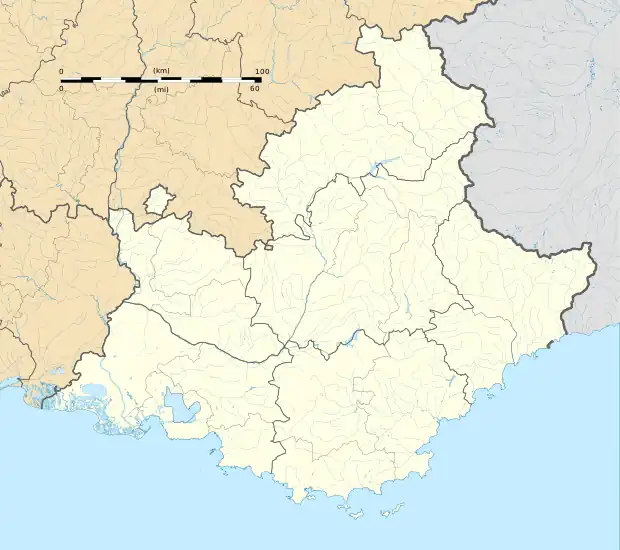Gignac-La Nerthe | |
|---|---|
 The Laure District of Gignac-la-Nerthe, with Marignane and the Étang de Berre, seen from the hill of Saint-Michel | |
.svg.png.webp) Coat of arms | |
Location of Gignac-La Nerthe | |
 Gignac-La Nerthe  Gignac-La Nerthe | |
| Coordinates: 43°23′35″N 5°14′08″E / 43.393190°N 5.235583°E | |
| Country | France |
| Region | Provence-Alpes-Côte d'Azur |
| Department | Bouches-du-Rhône |
| Arrondissement | Istres |
| Canton | Marignane |
| Intercommunality | Aix-Marseille-Provence Metropolis |
| Government | |
| • Mayor (2020–2026) | Christian Amiraty[1] |
| Area 1 | 8.64 km2 (3.34 sq mi) |
| Population | 10,083 |
| • Density | 1,200/km2 (3,000/sq mi) |
| Time zone | UTC+01:00 (CET) |
| • Summer (DST) | UTC+02:00 (CEST) |
| INSEE/Postal code | 13043 /13180 |
| Elevation | 11–128 m (36–420 ft) |
| 1 French Land Register data, which excludes lakes, ponds, glaciers > 1 km2 (0.386 sq mi or 247 acres) and river estuaries. | |
Gignac-la-Nerthe (French pronunciation: [ʒiɲak la nɛʁt]; Occitan: Ginhac) is a commune in the Bouches-du-Rhône department in southern France. It is located about 10 km north-north-west of Marseille and is primarily a residential community.
History
During Antiquity, what is now Gignac hosted a Roman villa.[3]
In the 13th century, the Knights Templar built the Saint-Michel de Gignac castle. After the Middle Age, agriculture developed (wheat, olive, vineries,…). The church of Gignac was built in 1780. At that time, Gignac was part of the Marignane seigneurie.[3]
The commune was created during the French Revolution. At first, it included Le Rove, which separated in 1835. In 1919, the commune changed its name from Gignac to Gignac-la-Nerthe to differentiate from other towns with the same name.
In the 19th century, many migrants from Spain and Italy came to live in the area, but the town only started to grow in the 1960s with the arrival of Pieds-Noirs from Algeria.
Geography and population
Gignac-la-Nerthe is situated just north of the Estaque hills and south of the Étang de Berre.
|
| ||||||||||||||||||||||||||||||||||||||||||||||||||||||||||||||||||||||||||||||||||||||||||||||||||||||||||||||||||
| Source: EHESS[4] and INSEE (1968-2017)[5] | |||||||||||||||||||||||||||||||||||||||||||||||||||||||||||||||||||||||||||||||||||||||||||||||||||||||||||||||||||
See also
References
- ↑ "Répertoire national des élus: les maires". data.gouv.fr, Plateforme ouverte des données publiques françaises (in French). 2 December 2020.
- ↑ "Populations légales 2021". The National Institute of Statistics and Economic Studies. 28 December 2023.
- 1 2 Histoire de Gignac-la-Nerthe Archived 2014-04-07 at the Wayback Machine, Michel Méténier, ville de Gignac-la-Nerthe, consulté le 18 mars 2013.
- ↑ Des villages de Cassini aux communes d'aujourd'hui: Commune data sheet Gignac-la-Nerthe, EHESS (in French).
- ↑ Population en historique depuis 1968, INSEE